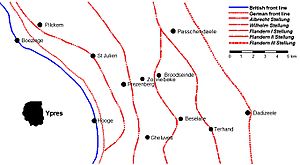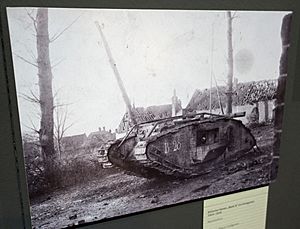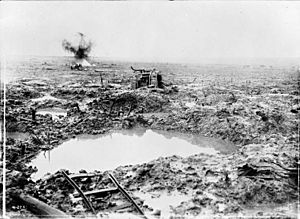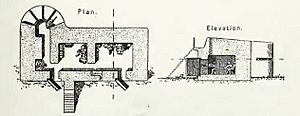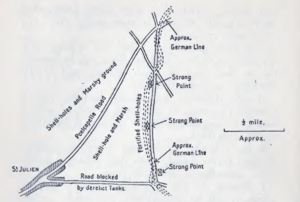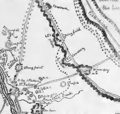Action of 22 August 1917 facts for kids
Quick facts for kids Action of 22 August 1917 |
|||||||
|---|---|---|---|---|---|---|---|
| Part of the Third Battle of Ypres of the First World War | |||||||
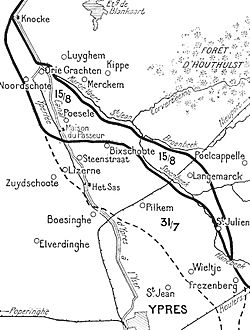 Front line after Battle of Langemarck, 16–18 August 1917 |
|||||||
|
|||||||
| Belligerents | |||||||
| Commanders and leaders | |||||||
| Sir Douglas Haig Hubert Gough |
Crown Prince Rupprecht Sixt von Armin |
||||||
| Units involved | |||||||
| 14th (Light) Division 15th (Scottish) Division 61st (2nd South Midland) Division 18th (Eastern) Division 11th (Northern) Division Tank Corps |
Gruppe Ypern | ||||||
| Strength | |||||||
| 6 brigades, 18 tanks | |||||||
| Casualties and losses | |||||||
| 4,508 (excl. XVIII Corps) | |||||||
The action of 22 August 1917 was a battle during the First World War. It took place in the Ypres Salient on the Western Front as part of the larger Third Battle of Ypres. The fight involved the British Fifth Army and the German 4th Army.
During the earlier Battle of Langemarck (August 16–18), the British had moved forward in some areas. However, they failed to capture a key German defense line called the Wilhelmstellung. To prepare for another big attack, the British planned smaller, local assaults. One such attack on August 19, called the action of the Cockcroft, was successful. British troops and tanks captured several fortified farms with few losses.
The attack on August 22 was a much larger effort. The British front line moved forward by up to 600 yards in some places. This happened along a 2-mile front. However, they did not reach their main goals. On August 24, a German counter-attack recaptured a key area called Inverness Copse. Because of this, a bigger British attack planned for August 25 was canceled. Heavy rain began on August 23 and got worse on August 26. This turned the battlefield into a muddy mess again. The British commander, Haig, then gave control of the offensive to General Herbert Plumer and the Second Army. The Fifth Army continued with smaller operations. On August 27, some fortified positions were captured with the help of tanks. But most attacks were costly and failed. The many casualties and the cold, wet, muddy conditions made soldiers on both sides feel very low.
Contents
Understanding the Battle
German Defenses
In 1917, the German army used a special defense system. It was called "defense in depth." This meant they had several lines of defense instead of just one. The first line had three parts, about 200 yards apart. These were manned by soldiers in listening posts. About 2,000 yards behind this was the Albrechtstellung. This was the back edge of the forward battle zone.
Scattered in front of this line were strongpoints. These included pillboxes, blockhouses, and fortified farms. These were built to be defended from all sides. The Albrechtstellung also marked the start of the main battle zone. This zone was about 2,000 yards deep. It held most of the German artillery. Behind this was the Wilhelmstellung. This line had more pillboxes and held reserve troops.
The Battle of Langemarck (August 16–18)
During the Battle of Langemarck, British troops attacked early in the morning. They were supported by tanks. However, the ground was so muddy that many tanks got stuck. The British managed to capture some areas, like the north end of St Julien. But they faced heavy machine-gun fire from German positions.
German troops launched counter-attacks. They tried to take back lost ground. The British faced fire from multiple directions. This caused many casualties. German artillery also fired heavily on the new British lines. This made it very hard for the British to hold their positions.
British Army's Lessons
After Langemarck, British commanders learned some lessons. They realized that German artillery was very effective. It could hit British troops trying to advance. One general, Oliver Nugent, suggested changes. He wanted fewer field guns in the "creeping barrage." A creeping barrage is when artillery fire moves forward slowly. This is meant to protect advancing infantry. Nugent wanted the extra guns to fire side-to-side. This would hit German troops hiding in shell holes. He also wanted the barrages to be slower.
Tanks were supposed to help capture German strongpoints. But they often got stuck in the mud. Air support was also difficult due to bad weather. Communication problems meant infantry often lost artillery support. This made German counter-attacks more successful. A report suggested shorter advances. This would give troops more time to dig in. It would also reduce communication problems in the mud.
Preparing for Battle
British Plans
After the Battle of Langemarck, the British had captured some ground. But many areas were lost to German counter-attacks. German strongpoints, fortified farms, and pillboxes were very numerous. German artillery focused on cutting off British attacking troops. They bombarded the British front lines. This caused delays for supplies and reinforcements.
German machine-gunners caused heavy losses. They fired from their strongpoints. On August 17, fresh British divisions moved into the area. But some tired divisions had to stay. The British planned to attack again on August 22. They hoped to reach better starting positions for a larger attack on August 25.
| Date | Rain mm |
°F | |
|---|---|---|---|
| 16 | 0.0 | 68 | dull |
| 17 | 0.0 | 72 | fine |
| 18 | 0.0 | 74 | fine |
| 19 | 0.0 | 69 | dull |
| 20 | 0.0 | 71 | dull |
| 21 | 0.0 | 72 | fine |
| 22 | 0.0 | 78 | dull |
| 23 | 1.4 | 74 | dull |
The British commander, Gough, was unhappy. He felt troops were not holding captured ground. He believed divisions were being rotated too often. This tired out fresh troops too quickly. For the August 22 attack, British artillery had to be very strong. It needed to silence German guns and machine-gunners. This was crucial for the infantry to move through the mud. British intelligence estimated they had more guns than the Germans. But their fire was spread out over a wide front.
British troops were to advance to specific roads and capture several German strongpoints. Machine guns would fire over their heads for support. For five days before the attack, British artillery fired at night. They also bombarded known German strongpoints. Patrols searched for German positions. To protect the attacking troops, other British units would provide smoke screens and covering fire.
German Defenses Ready
By July 31, the German front line had been pushed back. The main fighting happened in the "main battle zone." Here, German reserve troops fought against tired British attackers. The new German front line was made of shell holes. Behind these were fortified farms, strongpoints, and pillboxes.
On August 16, the British tried to capture the Wilhelmstellung. But their artillery failed to destroy many German strongpoints. It also did not stop German artillery. This German artillery caused most of the British casualties. The Germans held the higher ground. Their observers could direct artillery fire very accurately. British observers were on lower ground. German artillery was hidden by ridges. They could fire inwards, concentrating their power. The Germans also built fake positions. This was to trick British counter-battery fire. Bad weather also grounded British reconnaissance planes.
The Battle Begins
British Attacks on August 22
In the area of the 15th (Scottish) Division, troops attacked behind tanks. They also had a creeping artillery barrage. But the tanks got stuck before reaching the front line. As soon as the infantry moved, German artillery fire began. Machine-gun fire hit the attacking troops. It also hit support troops before they even left their trenches. Some British units lost direction in the confusion. They were caught by machine-gun fire from behind.
The advance was very costly. Some troops reached close to German strongpoints like Iberian Farm and Gallipoli. But they were stopped by heavy machine-gun fire. The 8th Seaforth tried to get around Gallipoli several times. All these attempts failed. By 7:00 a.m., it was clear the attack had failed. The front line had moved forward only a few yards. Many survivors were back at the start line. Small German counter-attacks were driven off later in the day.
The 61st (2nd South Midland) Division also attacked. They managed to capture Pond Farm. Its garrison of fifty German soldiers surrendered. They then pushed on and captured Hindu Cot. Another unit advanced on Kansas Cross. But supporting companies suffered many casualties. They captured Aisne and Somme farms. Aisne Farm was later recaptured by a German counter-attack. The British line advanced about 600 yards in some places. But attacks on Aisne Farm and Schuler Galleries failed on August 24.
The 48th (1st South Midland) Division attacked with tanks. The tanks were supposed to lead. But many were knocked out or got stuck. Some tanks helped capture the Springfield strongpoint. But it was later recaptured by a German counter-attack. The infantry captured Winnipeg, lost it, then recaptured it. But German artillery and machine guns stopped British reinforcements. By nightfall, some positions were captured and lost again. The division only advanced about 200 yards.
The 11th (Northern) Division attacked on the left. Two tanks led their advance. They drove towards Bülow Farm, a distant objective. The tanks found that the Germans had cut down trees to block the road. But they managed to drive over the obstacles. They fired their machine guns as they went. They found that the infantry had already arrived. The infantry were pinned down by fire from Bülow Farm. One tank was hit by a shell. But the second tank attacked the farm, which was captured. The 11th Division managed to reach its final objective. They linked up with another British division.
Fighting on the Gheluvelt Plateau
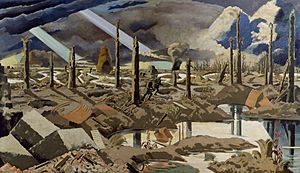
On the Gheluvelt Plateau, the 14th (Light) Division attacked Inverness Copse. One battalion entered the copse with few losses. They defeated a German company. The château south of the road was captured. About 60 prisoners were taken. But the German company fought hard. They reduced the British group to about 90 men. The second British battalion was caught by machine-gun fire. They lost the artillery barrage and had to take cover.
Three supporting tanks got stuck. But one tank forced the Germans from Inverness Copse. The second battalion moved up another 200 yards. But they were still far from their goal. German reserve troops counter-attacked. The British infantry were too weak to stop them. They fell back to the western edge of the Copse. Later, reinforced, the British held a line south of the Menin road. Around 5:00 p.m., more German troops advanced into the Copse.
Tank Experiences
Tanks were used in several areas. On the Gheluvelt Plateau, four tanks had some effect. In another area, 18 tanks were used. They hoped to find a way forward despite the destroyed roads. Where tanks got into action, they had a big psychological effect. Some Germans surrendered as soon as they appeared. Prisoners said they "felt helpless" against the tanks.
One tank, named Fray Bentos, got stuck near Gallipoli. Its crew was stranded for 72 hours. They fought off several German counter-attacks. They used their guns to repel German troops. British infantry sometimes fired on the tank, thinking it was captured. The crew tried to signal to their lines. But it failed. On August 24, one crewman was dead, and others were wounded. They had little food or ammunition left. Finally, a crew member crawled back and got the British to stop firing. The rest of the crew then escaped.
Aftermath
Casualties
The fighting on August 22 was very costly for the British. The 15th (Scottish) Division had over 2,000 casualties. The 61st (2nd South Midland) Division lost over 900 men. The 14th (Light) Division had over 1,500 casualties from August 22 to 24. Overall, the British suffered around 3,000 casualties in these attacks.
Smaller Actions (August 23–26)
Despite the failures on August 22, the fighting continued. Rain started again on August 23 and was very heavy on August 26. On August 24, Germans recaptured some gun pits using flamethrowers. British counter-attacks later found the pits empty.
On August 25, British troops attacked Gallipoli and Iberian farms. They advanced behind artillery fire. But they were shot down by hidden machine guns. They were also caught in crossfire. The survivors fell back. An attack on Aisne Farm also failed.
Action of August 27
On August 27, the British Fifth Army attacked again. Troops had moved up during the night in the rain. They waited for ten hours, soaking wet and in mud. Twenty minutes before the attack, heavy rain and a gale began. Smoke bombs, meant to create a screen, were soaked. The ground was full of waterlogged shell-holes. This made it hard for infantry to keep up with the artillery barrage.
In one attack, 120 men advanced. But they were forced back after reaching Gallipoli. Another attack was stopped about 100 yards short of its goal. After losing many men and officers, the survivors fell back. In another area, the 48th (South Midland) Division tried to advance 800 yards. Their first goal was a trench from Winnipeg to Springfield. Then they would advance to the German Wilhelmstellung.
The artillery barrage moved slowly. Higher ground was bombarded with smoke, shrapnel, and gas. Four tanks were supposed to help the advance. But as rain fell, water formed wide pools. Four tanks drove towards the Triangle. Some troops reached the gun pits. But two tanks got stuck.
Some German troops seemed surprised by the barrage. But as British soldiers struggled through the mud, the Germans resumed firing. One British company was ordered to advance to Springfield. Only about 15 unwounded men made it. In the rain and darkness, German fire was inaccurate. But as the group reached the stuck tanks, they faced shrapnel. They struggled on. When they reached the Triangle, German fire was going over their heads. Wounded soldiers joined them. A tank drove behind the Springfield blockhouse. But it was knocked out.
A group of British soldiers attacked Springfield from another side. The German garrison ran out. Sixteen prisoners were taken. But they were hit by German machine-gun fire as they moved back. The British decided that Spot Farm and the cemetery were too strong to attack. They dug in on a new line. Springfield was found to be very strong. It had thick walls and machine-gun posts. The 1/8th Warwick lost 66 men killed. The rest of the brigade was stopped short of its first goal. The 11th (Northern) Division made only a small advance. The 38th (Welsh) Division also attacked. But they lost the barrage in the mud. They faced fire from Pheasant Farm and the White House. By evening, the remaining troops were back where they started.
See Also
- List of British battles
- List of German battles
- Military history of the United Kingdom during World War I
- Military history of Germany during World War I
Images for kids
-
The Menin road (Paul Nash, 1919)


